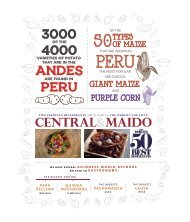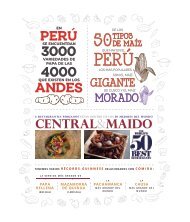You also want an ePaper? Increase the reach of your titles
YUMPU automatically turns print PDFs into web optimized ePapers that Google loves.
Pisco producing areas<br />
Zonas pisqueras<br />
Lima<br />
Ica<br />
Production<br />
Elaboración<br />
Arequipa<br />
Moquegua<br />
Tacna<br />
I am<br />
Peru<br />
Yo soy Perú<br />
The name<br />
The word “pisco” is Peruvian in origin.<br />
According to various chroniclers and<br />
historians, this Quechua word, refers to a<br />
type of seabird that lives around the area<br />
that came to be known as the Port of Pisco.<br />
El nombre<br />
La palabra “Pisco” tiene origen peruano.<br />
Según diversos cronistas e historiadores,<br />
este vocablo en quechua significa “Ave”<br />
o “Pájaro” de la zona donde se produce<br />
el Pisco.<br />
What is Pisco?<br />
It is the peruvian grape spirit obtained<br />
exclusively from recently fermented grape<br />
juice, a fact that makes it unique with 38<br />
to 43 grades of alcohol.<br />
¿Qué es el Pisco?<br />
Es un destilado de puro jugo de uva, sin<br />
ningún otro ingrediente. Esto lo hace una<br />
bebida singular y lo diferencia del resto de<br />
licores, puesto que tiene entre 38 y 43<br />
grados de alcohol<br />
Peru Gourmet, a Lima Tours program that is destined to show travelers<br />
the very best of Peruvian cuisine. The initiative is bound to promote<br />
native ingredients and national dishes abroad. We are proud to present<br />
Pisco, the Peruvian brandy.<br />
Peru Gourmet, un producto de Lima Tours, busca mostrarle al turista lo<br />
mejor de la cocina peruana. Se trata de una iniciativa para que los insumos y<br />
manjares peruanos, que nos llenan de orgullo, traspasen fronteras. En esta<br />
ocasión, les presentamos el Pisco, nuestra bebida bandera.<br />
Tasting<br />
Peruvian creativity always surprises with new pisco-based<br />
cocktails such as Chilcano, Aguaymanto Sour and Coca Sour.<br />
Yet the classic like pisco sour is irreplaceable.<br />
Para degustar<br />
La creatividad peruana siempre nos sorprenderá con<br />
novedosos cocteles hechos con este licor, como el Chilcano,<br />
el Aguaymanto Sour y el Coca Sour. Pero un clásico, como el<br />
Pisco Sour, es irremplazable.<br />
7<br />
Pisco<br />
Sour<br />
Chilcano<br />
Bottling<br />
Pisco is bottled in clear glass containers so<br />
that its purity can be appreciated. In<br />
ceramic containers just as in the colonial<br />
era when it was first produced.<br />
Embotellado<br />
El pisco se embotella en vidrio transparente<br />
para poder apreciar su pureza, o también en<br />
recipientes de cerámica, como en la época<br />
colonial, cuando empezó a producirse.<br />
6<br />
Aguaymanto<br />
Sour<br />
Coca<br />
Sour<br />
Aging<br />
The newly made pisco is aged in vessels<br />
known as "botijas pisqueras". It must be<br />
left for a minimum of three months.<br />
Reposo<br />
El pisco recién hecho se pone en cubas<br />
de reposo o botijas pisqueras. Debe<br />
reposar un mínimo de tres meses.<br />
1<br />
Pruning<br />
The vines are pruned<br />
in August otherwise<br />
they produce<br />
branches and leaves<br />
rather than grapes.<br />
Poda<br />
En agosto se poda la<br />
vid, de lo contrario se<br />
llena de hojas y<br />
ramas y pierde fuerza<br />
para producir racimos<br />
de uva.<br />
2<br />
Harvesting<br />
During February and<br />
March grapes contain the<br />
precise sugar level needed<br />
to obtain superb pisco.<br />
They are harvested and<br />
placed in baskets for<br />
transport to the winery.<br />
Vendimia<br />
Entre febrero y marzo,<br />
cuando los racimos<br />
contienen el nivel de<br />
azúcar adecuado para la<br />
elaboración del pisco, se<br />
recogen y se colocan en<br />
canastos para su traslado.<br />
3<br />
Pressing<br />
Traditionally, the grapes are pressed<br />
under foot in the winery. The fresh<br />
must then passes into a vat.<br />
Pisa o prensa<br />
La pisa tradicional se hace con los<br />
pies en un lagar. Luego, el mosto<br />
fresco pasa a la puntaya.<br />
4<br />
Fermentation<br />
The must is fermented in<br />
special vessels.<br />
Fermentación<br />
El mosto es colocado en<br />
recipientes especiales donde<br />
se fermentará.<br />
5 Distillation<br />
The fermented must<br />
is placed in the still.<br />
Heat is applied.<br />
Destilación<br />
El mosto fermentado<br />
39<br />
se lleva al alambique.<br />
Se echa en la paila y<br />
se le aplica calor.

















